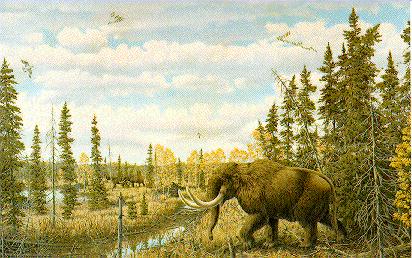Paleo-Indian Environment
 These first inhabitants lived in a very different North America than we see today. Large ice sheets covered much of the world's northern lattitudes. With so much water held by ice, sea levels were considerably lower. In fact it is lower sea levels that created a large land mass called Berengia on which Asian hunter-gatherers could cross from northeastern Siberia into what is today Alaska.
These first inhabitants lived in a very different North America than we see today. Large ice sheets covered much of the world's northern lattitudes. With so much water held by ice, sea levels were considerably lower. In fact it is lower sea levels that created a large land mass called Berengia on which Asian hunter-gatherers could cross from northeastern Siberia into what is today Alaska.
 The large Laurentide Ice Sheet extended from the Arctic Ocean to within only a few hundred miles of the American Bottom. The remains of mammals, insects, and plants that today live far to the north demonstrate that the climate was cooler than todays'. Tree pollen that fell into and was preserved in bog and pond sediments indicates that open spruce forests covered much of the landscape. Water levels on the Mississippi River were kept high by the discharge from the nearby ice sheet.
The large Laurentide Ice Sheet extended from the Arctic Ocean to within only a few hundred miles of the American Bottom. The remains of mammals, insects, and plants that today live far to the north demonstrate that the climate was cooler than todays'. Tree pollen that fell into and was preserved in bog and pond sediments indicates that open spruce forests covered much of the landscape. Water levels on the Mississippi River were kept high by the discharge from the nearby ice sheet.
The landsape of the American Bottom was shaped nearly 15,000 years ago when a torrential flood of glacial meltwater cascaded down the Mississippi valley. As this flood receeded, the river continued its sinuous meander southward, its flood plain left as a mosaic of streams, backwater lakes and sloughs. American Indian pioneers were the first humans to observe this landscape more than 12,000 years ago.
 These first inhabitants lived in a very different North America than we see today. Large ice sheets covered much of the world's northern lattitudes. With so much water held by ice, sea levels were considerably lower. In fact it is lower sea levels that created a large land mass called Berengia on which Asian hunter-gatherers could cross from northeastern Siberia into what is today Alaska.
These first inhabitants lived in a very different North America than we see today. Large ice sheets covered much of the world's northern lattitudes. With so much water held by ice, sea levels were considerably lower. In fact it is lower sea levels that created a large land mass called Berengia on which Asian hunter-gatherers could cross from northeastern Siberia into what is today Alaska.
 The large Laurentide Ice Sheet extended from the Arctic Ocean to within only a few hundred miles of the American Bottom. The remains of mammals, insects, and plants that today live far to the north demonstrate that the climate was cooler than todays'. Tree pollen that fell into and was preserved in bog and pond sediments indicates that open spruce forests covered much of the landscape. Water levels on the Mississippi River were kept high by the discharge from the nearby ice sheet.
The large Laurentide Ice Sheet extended from the Arctic Ocean to within only a few hundred miles of the American Bottom. The remains of mammals, insects, and plants that today live far to the north demonstrate that the climate was cooler than todays'. Tree pollen that fell into and was preserved in bog and pond sediments indicates that open spruce forests covered much of the landscape. Water levels on the Mississippi River were kept high by the discharge from the nearby ice sheet.